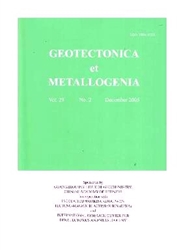CHARACTERIZATION AND FORMATION MECHANISM OF THE CENTRAL UPLIFT OF THE QIANGTANG BASIN
作者:YIN Fuguang
摘要:The Qiangtang basin is located between Kekexili-Jingshajiang suture belt and Bangong-Lujiang suture belt, and is divided into the north part and south part by the central uplift that has no crop out of Mesozoic strata. When the Jinshajiang Ocean was closed, the subducting plate was subducted southward. In the central part of the Qiangtang basin, the cushioning effect of the asthenosphere resulted in the thermal doming of the mantle and subsequent large-scale anatexis. Mantle source materials and antectic materials were upwelled and extruded into the middle crust, leading to the thickening of the middle crust and the heating and weakening of the middle to upper crust, and resulting in the rapid deformation (detachment) and tectonic erosion, and in the isostatic uplifting and the formation of metamorphic core complex. The upwelling of anatectic materials would further enhance the buoyant repercussion, which would combine with the side stress due from extrusion in resulting in the formation of an extensional stress field. The extensional structure and detachment fault are formed under the influence of the losing stabilized gravitation. In the deformation area in both the upper part and the lower part, an extensional deposition area would be formed, and this is the generation of a new basin.The metamorphic core complex of the central uplift is comprised of gneiss, which is itself overlain by non-metamorphic to weakly metamorphic covering strata intersected by faults.
发文机构:Chengdu Institute of Geology and Mineral Resources
关键词:QIANGTANGCENTRALUPLIFTFORMATIONmechanismQiangtangcentral upliftformation mechanism
分类号: P541[天文地球—构造地质学][天文地球—地质学]
- CHARACTERIZATION OF DEFORMATION AND X-RAY PETROFABRICS IN THE MIDDLE PART OF THE WAHONGSHAN FAULT ZONE, QINGHAI PROVINCE,NORTHWESTERN CHINA
- LATE CENOZOIC GOLD VEINS AND VOLCANIC COLLAPSE TECTONICS IN THE ISLAND ARC JUNCTIONS OF THE JAPANESE ISLANDS
- JUNCTION BETWEEN GANJIANG FAULT AND TANLU FAULT AND ITS SIGNIFICANCE TO MINERALIZATION
- EXPERIMENTAL GEOCHEMISTRY STUDY ON GOLD IN WATER-ROCK REACTION UNDER THERMAL FLUID SYSTEM AT MESO-LOW TEMPERATURE
- MULTI-ARC BASIN SYSTEM OF THE KUNLUN OROGENICBELT AND PAN-CATHYSIAN CONTINENTAL ACCRETION
- THERMAL MODELLING OF COLLISIONAL OROGENY:IMPLICATIONS FOR THE ULTRA-HIGH PRESSURE METAMORPHISM
- DEEP TECTONOTHERMAL MECHANISM FOR THE TECTONIC EXTENSION OF THE EASTERN ASIAN CONTINENTAL MARGIN
- GEOCHEMICAL CHARACTERISTICS OF THE EARLY MESOZOIC GRANODIORITES AND THEIR TECTONIC IMPLICATIONS
- FORMATION AND EVOLUTION OF THE CENOZOIC THRUST FOLD BELT IN JINPING, SICHUAN
- HISTORIC-DYNAMIC ANALYSIS OF GOLD METALLOGENY OF WEST SARAWAK,EAST MALAYSIS


